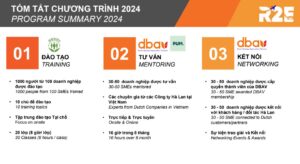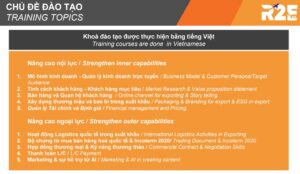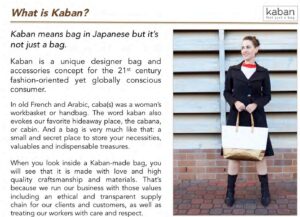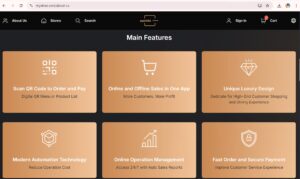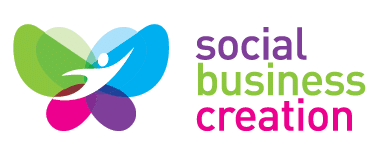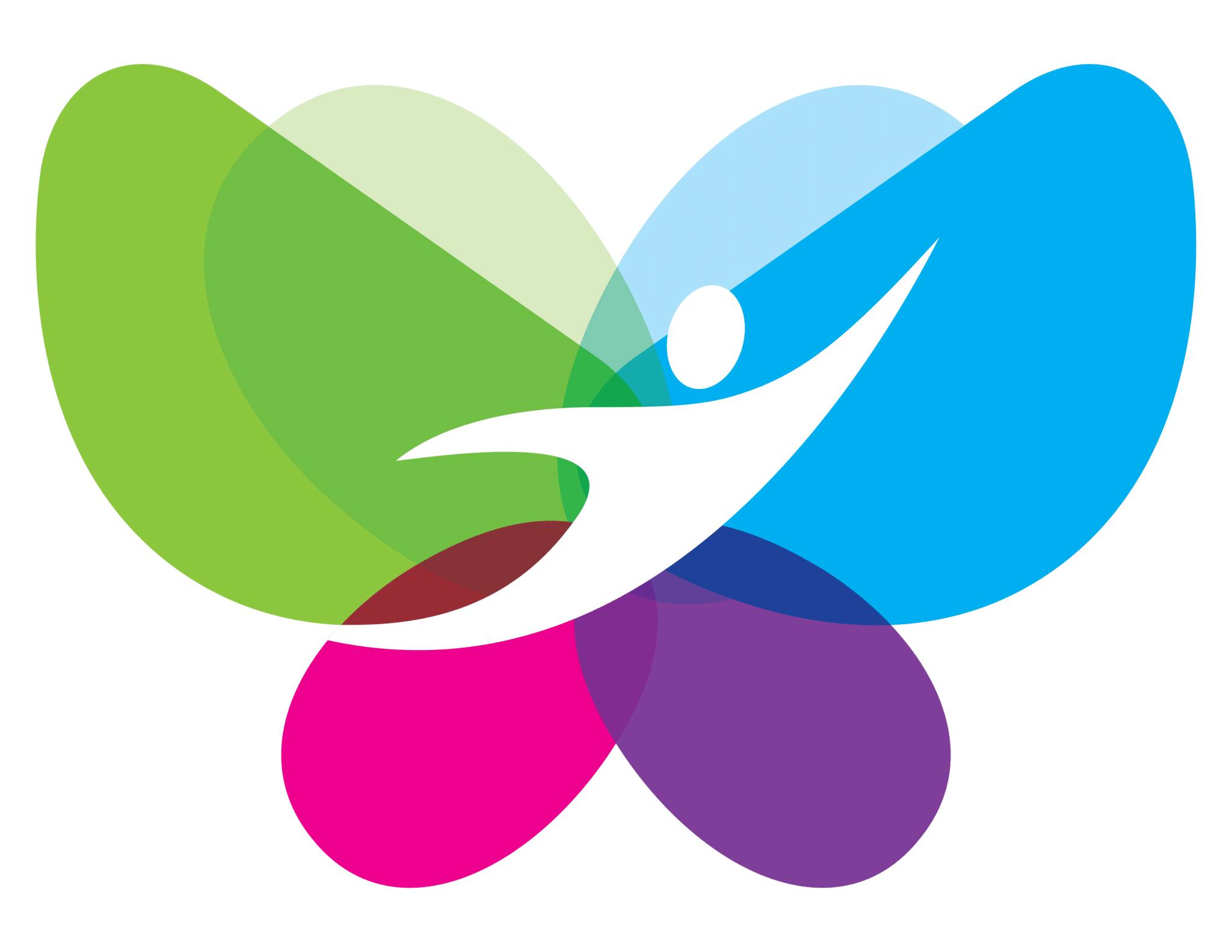SOCIAL IMPACT ACCELERATION
Update Final Booth case presentation Sep 27,2024: https://youtu.be/zaa8gPcnL7A
Final presentation: Green Cat Final Pitch
Video Pitch:
Presentation PDF version: in confidential folder
Reference & Evidence file: in confidential folder
Landing Page Round 4:
Social mantra
“Scaling ESG solutions in sustainable luxury fashion to promote natural cotton toward ethnic better income”
The one-liner’s development benefits from the key stakeholders’ feedback
“We still have a fertile land fund that is very suitable for continuing growing cotton crops next year.
Therefore, we hope that Green Cat will continue to accompany us and find stable purchasing output to help our community strongly develop”
Ms. Bin – Representative of Luc Nghiep Thanh cooperative in Hoa Binh Province – a key stakeholder who grows cotton & supplies us handwoven fabrics: feedback about accompanying Green Cat to grow cotton crops. (Voice records in evidence at point A.1)
- Journey of Cotton from farm to fashion product





2. From first prototype to go to market
| From the first concept
(Create sustainable bag prototype) |



Go to market (2019 – Present)

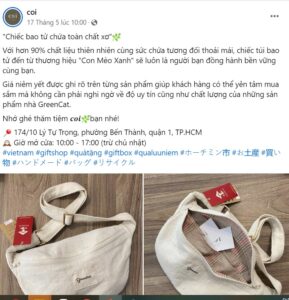
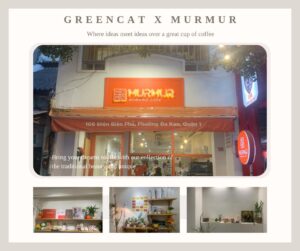
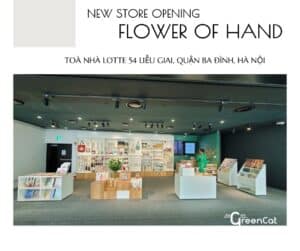
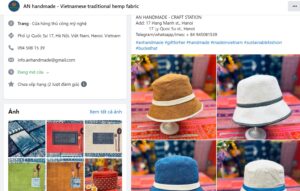
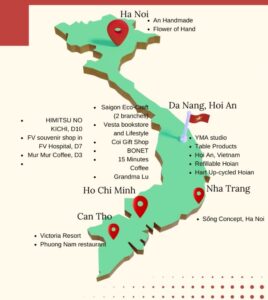
3. Transformative of our brand identity
| 2019:
Inspired by the Hemp plant, the first material in Green Cat product comes with a friendly natural color tone |
2024:
The logo was inspired by the image of Vietnamese women in traditional costumes from the 80s to modern times. Combined with the colors and accessories of the women ethnic group. Non la and Aodai is the identity of Vietnamese people, Greencat is a product originating from Vietnam, produced and developed by Vietnamese women. |
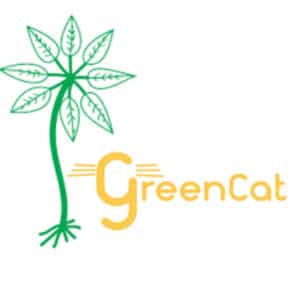
|
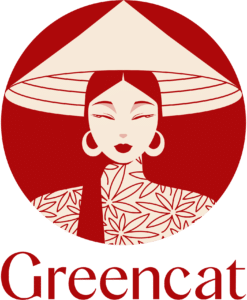
|
4. Product development
2019 – 2022: 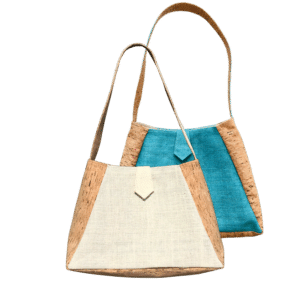
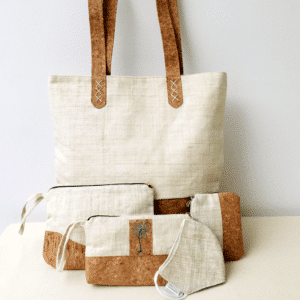
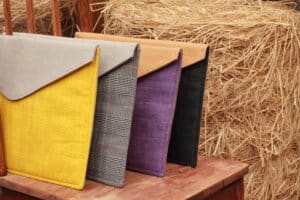
2023 – 2024: 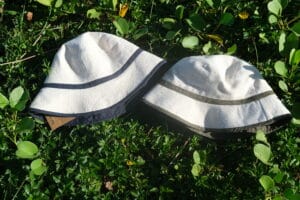
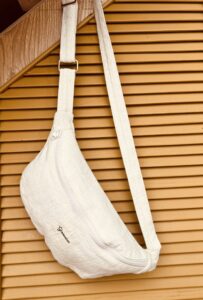
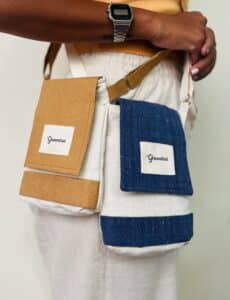
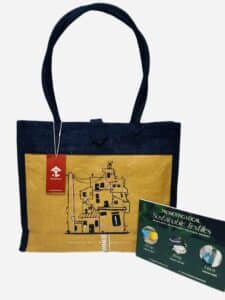
5. Events from 2019 to present:
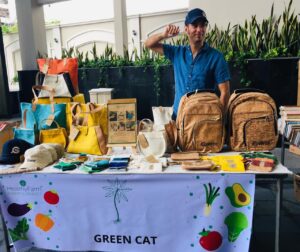
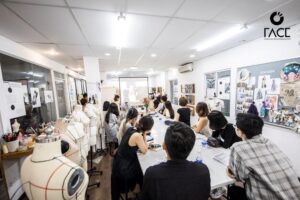
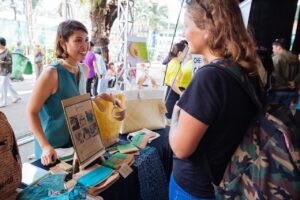
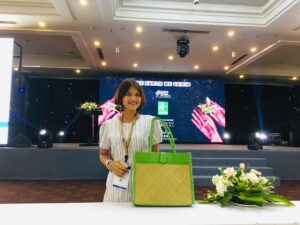
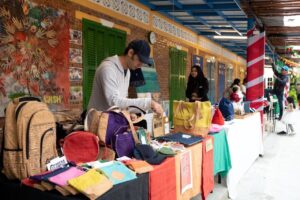
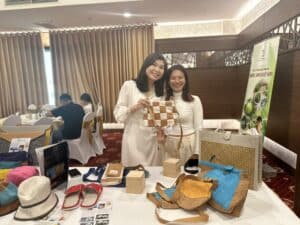

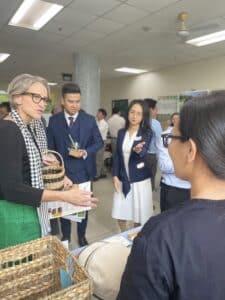
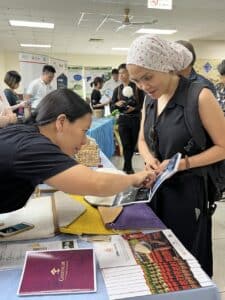
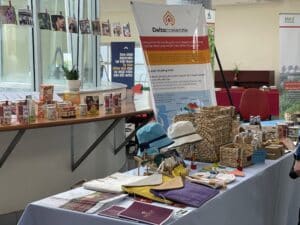



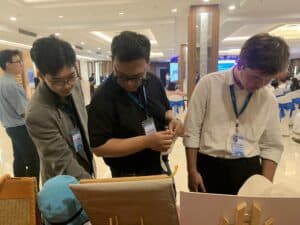
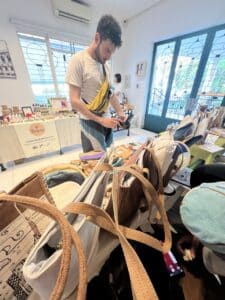
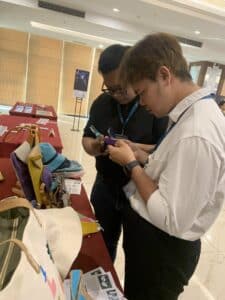
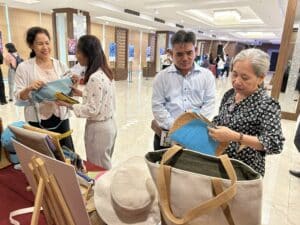
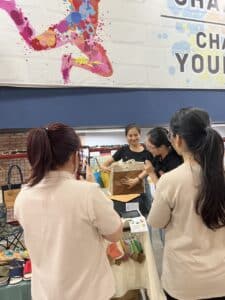
The one-liner is widely shared/promoted by others
“Green Cat has a meaningful story for women ethnic minorities.
The ultimate goal is not to sell products but to contribute to society”


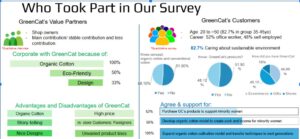
Social media engagement
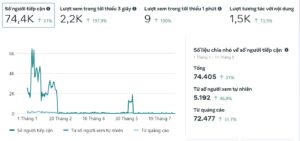
A2. Social impact clarity and significance
Describe your motivation to solve your target social/environmental issues and demonstrate their significance. The analysis is based on valid data from statistics, interviews, observations, etc and references come from reputable sources
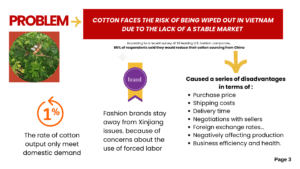
Summary:
The cotton output only meets 1% of domestic demand, the rest is forced to be imported from many countries around the world.
This problem has caused a series of disadvantages in terms of purchase price, shipping costs, delivery time, negotiations with sellers, foreign exchange rates… negatively affecting production and business efficiency and health.
Fashion brands stay away from Xinjiang issues. because of concerns about the use of forced labor.
Data from the US Department of Commerce shows that in the first 5 months of this year, the US imported 21.5% of cotton products from China, down 3.7 percentage points compared to 2020. Meanwhile, the proportion of imports from India from 16.5% to 19.2%. Vietnam’s market share has remained at around 9% over the past two and a half years.
According to a recent survey of 34 leading U.S. fashion companies, 86% of respondents said they would reduce their cotton sourcing from China
(Please see reference in REF file at point A.2.5)
Cotton journey in Vietnam through the past to present
The Top to down perspective
Current status of cotton (conventionally cultivated cotton) in its heyday in 2000
Vietnam’s cotton industry is completely dependent on imported raw materials. This problem has caused a series of disadvantages in terms of purchase price, shipping costs, delivery time, negotiations with sellers, foreign exchange rates… negatively affecting production and business efficiency and health. competition of each spinning enterprise.
According to statistics from the Vietnam Cotton Association (Vcosa), the early 2000s are considered the golden age of cotton. Key growing areas: Ninh Thuan, Binh Thuan, Dak Nong, Son La
From 2006 onwards, the total cotton growing area has decreased until 2011. The cotton growing area is being actively restored by the Central Highlands provinces, but the output only meets 1% of domestic demand, the rest is forced to be imported from many countries around the world.
| Year | Acres | Cotton seeds | Cotton lint |
| 2000 | 32.000 ha | N/A | N/A |
| 2006 | 17.300 ha | N/A | N/A |
| 2007 | 3.000 ha | N/A | N/A |
| 2010 | 10.400 ha | N/A | N/A |
| 2011 | 11.500 ha | 1.1 tấn/ ha | 0.35 tấn/ ha
|
The value of textile and garment turnover is among the top key export products.
The industry’s added value is low because raw materials depend on imports, 99% of cotton fibers must be imported from abroad. According to 2011 statistics, the demand for fiber is interpreted as follows:
| Total domestic needs | 370.000 ton/ year | 100% |
| Việt Nam capacity | 4.000 ton/ year | 1% |
| Import from Africa | 72.000 ton/ year | 20% |
| Import from India | 120.000 ton/year | 30% |
| Import from USA | 130.000 ton/ year | 30% |
(Ref file in A.2.1)
According to data on the current situation and forecast of Vietnam’s cotton industry in 2019
Table 1: Cotton output in our country by region, 2008 – 2010
| 2008 | 2009* | 2010* | |||||||
| Areas | Acre | Prod | Quan | Acre | Prod | Quan | Acre | Prod | Quan |
| 1000 ha | m/ton /ha | 1000m/ ton | 1000 ha | mét tấn /ha | 1000m/ ton | 1000 ha | 1000m/ ton | 1000 ha | |
| Red river delta | 0,00 | 0,00 | 0,00 | 0,00 | 0,00 | 0,00 | 0,00 | 0,00 | 0,00 |
| Northeast | 0,26 | 1,20 | 0,32 | 0,30 | 1,20 | 0,36 | 0,30 | – | – |
| Northwest | 2,20 | 1,13 | 2,49 | 2,20 | 1,15 | 2,53 | 2,20 | – | – |
| North Central Coast | 0,05 | 0,42 | 0,02 | 0,10 | 0,50 | 0,05 | 0,10 | – | – |
| South Central Coast | 0,90 | 2,29 | 2,06 | 1,00 | 1,60 | 1,60 | 1,00 | – | – |
| Highlands | 0,78 | 1,28 | 1,00 | 2,50 | 1,21 | 3,03 | 3,20 | – | – |
| Southeast | 1,01 | 1,13 | 1,14 | 1,90 | 1,28 | 2,43 | 2,20 | – | – |
| Mekong Delta | 0,01 | 0,06 | 0,00 | 0,01 | 0,60 | 0,01 | 0,01 | – | – |
| Total | 5,21 | 1,35 | 7,02 | 8,01 | 1,25 | 10,00 | 9,01 | 1,30 | 11,71 |
Source: Ministry of Agriculture and Rural Development, General Statistics Office. (*): estimate
Forecast of cotton production for the 2010/2011 crop year
The cotton growing area in our country in the 2010/2011 crop year is estimated at about 9,000 hectares, a slight increase compared to the 2009/2010 crop year. The sharp increase in demand for corn consumption for the animal feed industry as well as the fact that corn cultivation is more profitable than cotton cultivation has caused many farming households to switch from growing cotton to growing corn, also causing the cotton planting area of the country to increase. Our country is not growing strongly.
Table 2: Cotton production situation in our country from crop year 2007/2008 to crop year 2010/2011
| 2007/08 | 2008/09 | 2009/10
(estimate) |
2010/2011*
(target) |
|
| Crop area (1000 ha) | 12,4 | 5,21 | 8,01 | 9,01 |
| Crop productivity
(m/ tons/ha) |
1,3 | 1,35 | 1,25 | 1,30 |
| Cotton seed output (thousands of tons) | 16,12 | 7,033 | 10,00 | 11,71 |
| Grain separation rate (%) | 36,5 | 36,5 | 36,5 | 36,5 |
| Cotton output (thousands of tons) | 5,88 | 2,57 | 3,65 | 4,28 |
| Quantity (1,000 parcels) | 27,01 | 11,80 | 16,76 | 19,64 |
Source: Ministry of Agriculture and Rural Development, General Statistics Office.
Consume
Domestic cotton consumption continues to increase to meet the expanding needs of the textile industry in Vietnam. There are 145 spinning factories with a capacity of 350,000 tons of cotton fabric/year. Domestic cotton consumption increases at an average rate of 9-10%/year. It is estimated that domestic cotton consumption in the 2008/2009 crop year is about 261,000 tons (or 1.2 million bales), in the 2009/2010 crop year is 300,000 tons (equivalent to 1.38 million bales) and in the 2010/2011 crop year is 320,000 tons. tons (equivalent to 1.47 million bales).
Signs of improvement for the ambition to restore the cotton crop according market research since 2018 to present (Ref. file at point A.2.4)
US ban on Xinjiang cotton imports
In recent years, the proportion of textile and garment exports from South Asian countries to the US has gradually increased by taking advantage of the shift of production capacity in labor-intensive industries out of China.
The US boycott of Xinjiang cotton is another catalyst for this trend, which could fundamentally reshape the global textile supply chain by isolating China – a textile producer, exporter and consumer. The world’s largest sewing machine.
Data from the US Department of Commerce shows that in the first 5 months of this year, the US imported 21.5% of cotton products from China, down 3.7 percentage points compared to 2020. Meanwhile, the proportion of imports from Bangladesh increased from 8.4 percentage points in 2020 to 10.2%, India from 16.5% to 19.2%. Vietnam’s market share has remained at around 9% over the past two and a half years.
But for countries like Vietnam and Bangladesh, despite becoming increasingly competitive with garment manufacturers sourcing from Western markets, they still rely heavily on China. about fabrics and fibers, especially high-quality raw materials.
Find ways to expand production capacity
According to a recent survey of 34 leading U.S. fashion companies, conducted from April to June by Sheng Lu, associate professor in the University of Delaware’s Department of Fashion & Apparel Studies, in collaboration with the American Fashion Industry Association, 86% of respondents said they would reduce their cotton sourcing from China, while more than 92% had no plans to reduce their apparel sourcing from other countries. Asian countries other than China because of this action.
Since the Sino-US trade war began in 2018, the share of US imports from Vietnam, Thailand and other countries has increased significantly. The report said the proportion of these countries’ imports from China also increased significantly. This means that countries such as Southeast Asia and India have begun to expand their own production capacities, and signs of relocating some labor-intensive industries from China have become apparent. should be clearer.
Fashion brands stay away from Xinjiang issues. According to Tuoi Tre newspaper on March 30, 2021.
Multinational fashion companies such as H&M, Nike, Adidas, Burberry, New Balance and Zara are stuck in that contradiction. These companies issued a statement late last year that they did not use Xinjiang cotton because of concerns about the use of forced labor, and now that statement is being pulled out to call out consumers and Chinese celebrities and actors. Quoc severed ties with related brands.
Comparison between organic cotton & industrial cotton (Ref. A.2.9 )
To better understand the difference between organic cotton and conventional cotton, we will compare them through: Production process, weeding, cotton growing, safety and hypoallergenicity for sensitive skin, purity purity of cotton; sustainable, water-saving and ethical practices.
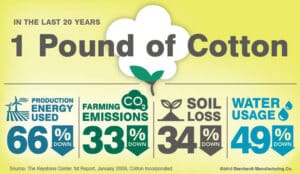
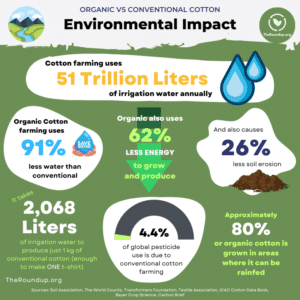
Organic Cotton Market Value (A.2.10)
The worldwide market for organic cotton is expected to experience significant growth, increasing from a valuation of $637.1 million in 2021 to an estimated $6.73 billion by the year 2028.
Overall sales of organic textile products in the US increased 10% over the prior year, reaching $2.3 billion in 2021.
- During this forecast period from 2021 to 2028, the market is anticipated to expand at a Compound Annual Growth Rate (CAGR) of 40.0%.
- The price of organic cottonseed varies between $500 and $740 per ton. This is significantly more valuable than regular cottonseed, where prices range between $275 to $460 per ton.
- Overall sales of organic textile products in the US increased 10% over the prior year, reaching $2.3 billion in 2021.
- Estimates suggest there could be an 84% increase in the demand for organic cotton by 2030, compared to that in 2020.Source: USDA, OTA, Fortune Business Insights, Organic Cotton Demand Insights Report
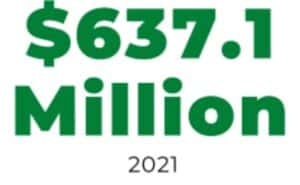
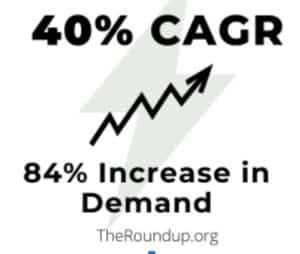
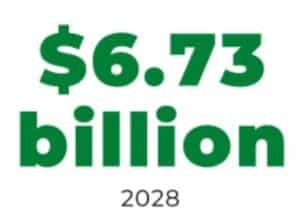
Introduction
Green Cat started from sourcing traditional Vietnamese textile materials to produce fashion products such as bags, hats, etc.
Since 2019, in the process of in-depth learning from field trips from rural areas with a lifelong tradition of handloom weaving. Green Cat is inspired by the cultural stories associated with the textiles of ethnic minorities, especially women.
Green Cat’s products have since been selected to combine hand-woven hemp and cotton fabrics along with other environmentally friendly fabric sources such as waterproof paper fabric and oak bark fabric. During 5 years of operation, we have cooperated with more than 20 retail stores to distribute products to the market.
Along with purchasing fabrics to create products, Green Cat understands the desire of Muong women to restore cotton crops because in addition to its economic value, cotton is also associated with traditional crafts. their lifespan. We have accompanied Luc Nghiep Thanh Cooperative to search for original varieties (2008) and planted them on a trial basis. Up to now (2023 – 2024), cotton plants have grown stably with an area of 5000m2. Therefore, we implemented a project to develop cotton plants to increase the ability to generate income for ethnic women as well as help Green Cat develop in the coming years.
However, recovering cotton is not easy, in the context of the fact that the cotton growing area has gradually shrunk and is at risk of disappearing over the past 10 years.
The journey to restore the first cotton field
| 2008 | 2009 | 2019 | 2022 | 2023 – 2024 |
| A few household still keep retain cotton fibers to weave a sample of cotton fabrics and sell to Green Cat | Mrs. Bin (Muong woman) had to collect from each household because they still kept the yarn and cotton making tools to weave fabric to provide Green Cat during our first trial tests. | The crop season was damaged and Muong women lost all their seeds and completely stopped growing cotton. | Green Cat found and bought cotton seeds and in 2023 Muong women planted their first crop. | Cotton planted over 1,000 square meters and harvested 70-80 kg of cotton, woven with traditional wooden frames to produce 800 meters of 36cm fabric.
In 2024, the seeds are expanding to other cooperatives in the Muong and Thai communities in Tan Lap, Mai Chau and Thanh Hoa with a total cotton growing area of about 5,000 square meters. |
The transformation of cotton, from seeds to sustainable products
| Cotton crops | Cotton Lint | Cotton Yarn | Finish products |
Project to regenerate cotton plants and move towards organic cotton
Green Cat from the starting business model produces environmentally friendly fabric bags. Up to now, after deeply accessing the market and conducting research surveys. We realize the potential to regenerate cotton plants and be able to expand the growing area, bringing stable economic efficiency to the ethnic minority community and allowing us to represent one of the local companies in the supply value chain.
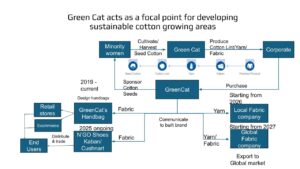
A3. Solution effectiveness and ESG integration
Describe how you address the target social/environmental issues and report your effectiveness according to environmental, social, and governance (ESG) criteria.
- There is strong evidence of positive outcomes
- There is a robust track record of sustainable positive outcomes since the beginning of the project
- Evidence of effective adoption of ESG practices and measurement
Why Hoa Binh Province (A.3.1-2-3-4)
According to the representative of Luc Nghiep Thanh Cooperative, Hoa Binh, according to so and so, the minority community groups are cultivating cotton in a natural way on lands with enough moisture for the plants and little irrigation, and the experimental growing area has increased. And according to the document source agroforestry system in Hoa Binh, the potential for agricultural development in Hoa Binh province is still large.
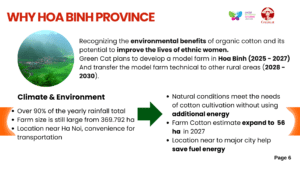
According to Decision No 1648/QD- TTg dated 20/12/2023 from the Prime Ministry approved for zoning Hoa Binh from 2021 – 2023, division to 2025. In the highlight note, important issues to invest in include Green Agriculture, Ecotourism, Electricity industry…
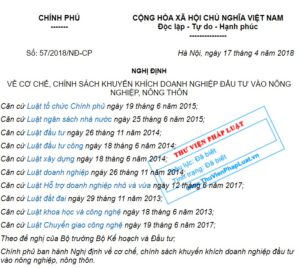
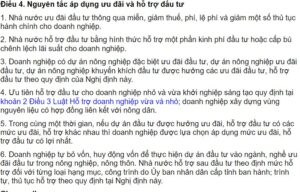
After carefully evaluating and researching the potential and risks of the cotton industry market. Green Cat chose Hoa Binh as the site to develop the first modeling organic cotton farm area and will replicate it in other rural areas with suitable natural conditions as well as favorable policy conditions so that Green Cat can easily coordinate with Cooperatives to create the transformative ecosystem for garment value chains.
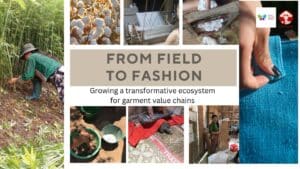
Summary of the situation of rural women, ethnic minority women and children. According to the United Nations Agency for Gender Equality and the Empowerment of Women (UN Women) published in 2015 (Ref. A.3.6)
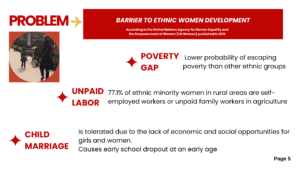
- Ethnic minority girls have access to education. In addition, ethnic minorities have a lower probability of escaping poverty than other ethnic groups.
- 77.1% of ethnic minority women in rural areas are self-employed workers or unpaid family workers in agriculture.
- The practice of child marriage is tolerated due to the lack of economic and social opportunities for girls and the concept of trust that young women are needed to undertake unpaid labor, such as household production and other domestic care work. Child marriage also causes early school dropout at an early age.
By continuing towards sustainable development that is beneficial to the community, the environment and Green Cat’s business model. Our goals “To be a changemaker business that creates sustainable positive change for minority communities and the environment” in 2025 are as follows:
For ethnic minority women & also improve household economic : (Financial sheet in confidential)
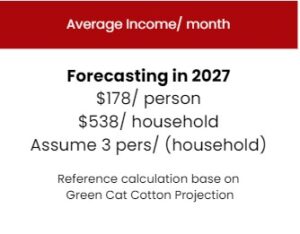
Weath:
- Our target is to reach the full capacity of 487 women members in 4 cooperatives who are willing to cooperate with us and reach 1155 women & farmers in 10 cooperatives by 2030. Their income increased by arrayed in different streams as: produce raw cotton fiber & handwoven cotton fabrics to sell to us.
- It can be multiple the capacity after first 3 years

Health:
- The scale and Farm family health has greatly improved due to stopping use and exposure to hazardous pesticides.
- Family food security is improving, from being able to grow more food crops safely, without pesticide residues, and increased production
Education:
- Farmers’ management capacities are improved and strengthened through the required internal control systems for organic certification.
- Involvement in farmers associations ensures that farmers have a bigger say in the changes organic farming families want to see.
- Increased income is often invested in sending children to (secondary) school. Estimate 770 students can access for high level school. (I.e. In Vietnam, the dropout rate among rural children at the secondary school level is high because of difficult family circumstances, so when they are old enough to work, they often drop out of school to join labor and help family economic)
Environmental Impact of Organic
| Advantage | Organic cotton is cotton that is grown naturally, without the use of chemicals like pesticides and fertilizers.
Use less water source, less energy, good renewable ability and contribute to biodiversity. |
| Disadvantage | Productivity in the beginning was low, using a lot of land and labor for farming |
| Conclusion | Consider the advantages & disadvantages of cotton crops coming up with a balanced strategy. We still choose organic farming to ensure environmental health and in a context where ethnic women still face many work limitations, this solution provides jobs and the ability to generate stable income. |

Supply Chain Impact
While organic farming is more environmentally friendly, it’s also important to consider the entire supply chain.
From processing to manufacturing, organic cotton generally has a lower carbon footprint and less environmental impact (with a 40% lower global warming potential) compared to normal cotton. This makes it a more sustainable choice throughout its lifecycle.
BUSINESS HIGHLIGHT
By creating added value for original raw materials such as hemp and accompanying Muong women to restore cotton. In Green Cat ecosystem, we only choose to cooperate with other distribution partners with the same value towards supporting and promoting local products. We practice fairtrade together as well as transparency about origins towards sustainable development
| Categories | Number of impact | Outcomes |
| PEOPLE
Gender equity |
487 Minorities members in Hoa Binh
30 Minorities artisans in Ha Giang
04 Women in workplace
|
100% women
in vulnerable group (minority, single mom, middle aged) |
| PLANET
Life on land Climate Action |
100% Textiles from natural, biodegradable
10% Recycle resources
Organic cotton lint
|
Sustainable
Product Handwoven process Natural dyeing Less harmful to planet Animal friendly Restore cotton in sustainable farming: Organic farming practices contribute positively to soil health, reducing water, energy. |
| CLIENTS
Partnership for goals Responsible Consumption and Production |
22 Retails stores
* 12 store in HCM * 05 store in Danang * 05 store in other cities 07 Online marketplace
02 Distribution in 2025 – 2027 onwards
|
End Users: Gain awareness of consumerism behaviors through responsible consumption & production activities.
Fair for life: encourages fair trade and labor practices, ensuring that workers in production industries operate in safe and equitable conditions. |
| COMMUNITIES
Partnerships for the goals |
Top 30 regional
SBC global competition – Round 2, 3 06 groups 2023:
(Women Entrepreneurs community)
(promoting Vietnam’s clean energy movement & supporting entrepreneurs and startups with incubation, acceleration and funding opportunities)
(national organization that gathers and represents the business community, employers and business associations in Vietnam) 2024:
(U.S. Exchange Alumni networks to help women and their businesses grow, driving localized prosperity in communities in more than 100 countries worldwide)
(Circular Economy network)
(Impactful Global platform for social Entrepreneurs to enhance ESG)
(Ready to Export Dutch Business Association in Vietnam) |
Improving access to knowledge & enhance innovation
Interconnected for good cause and support each other to expanding the growth opportunity in communities |
B1. Mechanisms to accelerate impacts
Explain how you rapidly increase your social impact in the next 3-5 years.
- There is strong evidence of scalability from past projects or pilots
- There is strong evidence of sufficient capabilities to execute the growth strategy
Green cat’s important output links in the supply chain
Green Cat shared the story of the Muong people’s desire to restore cotton to the community in the garment manufacturing industry and received positive feedback along with prospects for purchasing cotton fibers from representatives of Alvin & Ashley Enterprise Limited in the next few years.


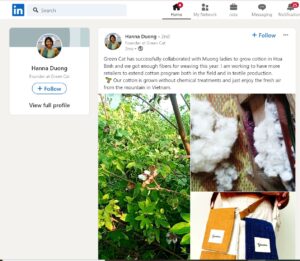
Green Cat’s initial business model was to purchase hand-woven fabrics and design finished products of fabric as bags and hats with sustainable materials. We have succeeded in initially adding value to the original source of cotton fiber.
Up to now, Green Cat has cooperated with more than 20 souvenir shops in major cities in Vietnam. Most of our main customers are European, American, Korean, Japanese tourists and some young Vietnamese people in the community who love the environment and live green.

Green Cat also develops e-commerce sales channels such as:
In Vietnam: Shopee, Chus, Lazada, Tiktok
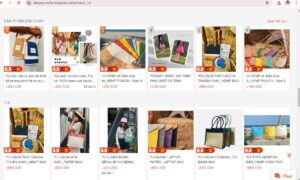
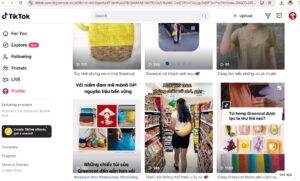
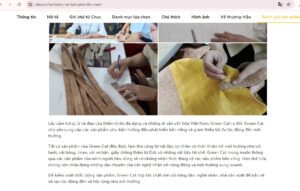

In France: Etsy, Meanwhile
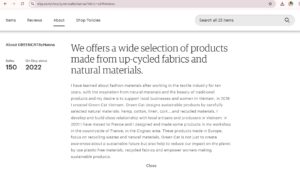
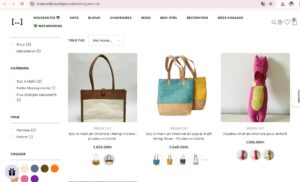
Green Cat roadmap in next 5 years
| Categories | 2025 | 2026 | 2027 | 2028 | 2029 |
| Cotton
Crops |
Internal inspection & training agriculture technical – Collaborate with University, Institute | Cotton Crops expanding | Get USDA cert | Expand to other rural areas in the North VN | Expand to other rural areas in the Middle & South VN |
| Cotton Lint,
Fabrics |
N’go Shoes
LustnArt Kaban |
Collab more brands as: Bitis | Distribute to domestic manufacture | Export to Alvin & Ashley | Export to other Distributors |
| Green Cat products | 20 retail stores
04 online platform (VN) 02 online platform (France) 01 online platform (VN) |
Engage to Domestic airline: Viet Jet Air, VN Air
Export to Dutch by corporate with Dutch local brand |
x 3 retail stores
Export to other local brands in other countries |
||
Value Solutions and Development Opportunities
Global Organic Cotton Market Size
The worldwide market for organic cotton is expected to experience significant growth, increasing from a valuation of $637.1 million in 2021 to an estimated $6.73 billion by the year 2028.
Overall sales of organic textile products in the US increased 10% over the prior year, reaching $2.3 billion in 2021.
- During this forecast period from 2021 to 2028, the market is anticipated to expand at a Compound Annual Growth Rate (CAGR) of 40.0%.
- The price of organic cottonseed varies between $500 and $740 per ton. This is significantly more valuable than regular cottonseed, where prices range between $275 to $460 per ton.
- Overall sales of organic textile products in the US increased 10% over the prior year, reaching $2.3 billion in 2021.
- Estimates suggest there could be an 84% increase in the demand for organic cotton by 2030, compared to that in 2020.
Source: USDA, OTA, Fortune Business Insights, Organic Cotton Demand Insights Report
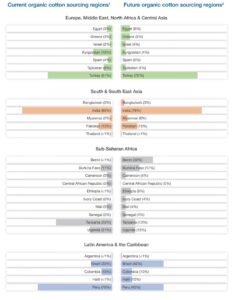
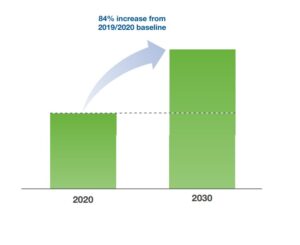
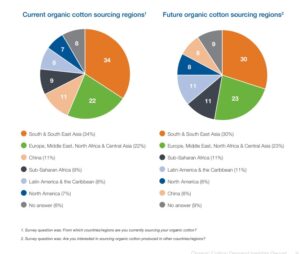
| Global Market | Vietnam Market |
|
|
Organic Cotton Market Geographic Share
Although the cotton supply market from large countries still dominates, this industry still relies on each other in the supply chain to prevent risks of supply disruption. Therefore, countries with sources of supply always maintain purchasing output from countries with small sources of supply.
Green Cat also applied this same method to design a roadmap to expand growing areas from Hoa Binh Province to other provinces stretching from the North to the Highland and down to the Southwest 2027 – 2030
- According to Decree 57/2018/ND-CP Preferential policies for businesses that prioritize the use of local raw materials. (Ref. B.1.5)
- Reduction of taxes, fees, charges and reduction of some administrative procedures for businesses.
- Supports investment in the form of partial support for investment costs
- Enterprises with special agricultural projects with investment incentives
- Prioritize investment support for innovative small and medium-sized startups specifiedEnterprises building raw material areas have contracts with farmers.
- The State provides post-investment support according to support norms for each type of item and project issued by the Provincial People’s Committee


- According to The OEKO – Tex Organic Cotton Certification, in 2023 offered a comprehensive and objective testing for organic cotton products with a fully verified chain of custody. The focus is product and consumer safety as well as traceability. (Ref. B.1.6)
SWOT Analysis for growing cotton crops
| STRENGTH | WEAKNESS |
|
|
| OPPORTUNITIES | THREATS |
|
|
The business acceleration strategy is divided into stages
In past years: From farm to fashion bags
Green Cat purchases hand-woven cotton fabric directly from compatriots and adds product value by creating fabric in unique fashion bags that are convenient for daily needs.
Customer portrait: tourists (EU, US, AU) and female groups in the green living community.
Solving their pain point:
- Tourists have little choice when buying traditional souvenirs at local tourist souvenir shops in Vietnam as a gift and often those souvenirs are rarely used on a daily basis, creating waste.
- Eco canvas bag products on the market are popular for the green living community but it is inconvenient for them to dress in conferences and parties.
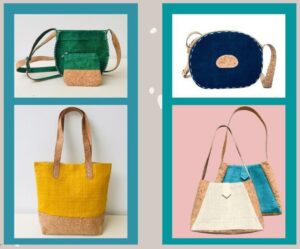
This year:Start with WHY
Identify the scale up potential of new product lines & new customers segment and non-geographic expansion potential. To better meet market needs, Green Cat is changing communication strategies starts with Why
- Cotton Farming: cotton is still in the germination stage with a small yield just enough to be woven into fabric for Green Cat to create products. Therefore, our goal is to develop growing areas and increase the value of cotton fibers during this incubation period of 2-3 years.
- From farm to products: to ensure a stable financial lifeline during the cotton farm incubation period. Green Cat designs additional product lines such as backpacks and hats for daily use. And increase the variety of souvenir products that mark traditional Vietnamese culture.
Customer portrait:Tourist (Japan, Korea, Sing) & Student; office worker
Solving their pain point:
- Tourists: meet their trend (minimalist, tiny detail patterns)
- Mostly in Vietnam, every individual riding a motorbike or bicycle uses a backpack to ensure safety when wearing it because street robberies happen every day, especially in Ho Chi Minh city area.
Communicate tactic: from farm to fashion products, sustainable fabrics, promote ethnic ancient craft, empower ethnic women
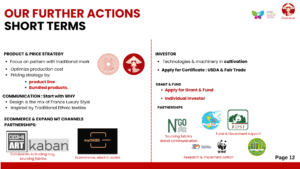
In next 2 – 3 years:
In order for cotton to achieve good yields and achieve USDA organic certification, Green Cat needs coordination with participating parties including: farmers (ethnic minorities), local governments, institutes of science and technology, University of Agriculture and Forestry, inspection organization according to international organic standards, NGO…
The key point of the project is to grow cotton according to organic standards to bring the best product value to consumers & best value to all related stakeholders while still ensuring environmental safety criteria.
Based on market survey research and available resources, Green Cat plans the project in 3 phases including:
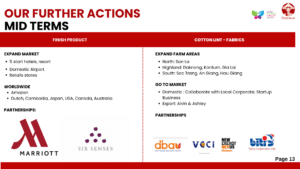
In order for the cotton regeneration project to be well developed and to avoid supply disruptions in the supply chain, the cotton farm modeling project has enough evidence for scale up. We will also transfer the modeling to rural areas with suitable natural conditions such as: Son La, Dien Bien, Kon Tum, Dak Nong, Ninh Thuan, Soc Trang, An Giang, Hau Giang… These areas, according to research (check in reference at point B1), are suitable for cultivating cotton crops in alternating seasons and rotating crops with other varieties to increase economic viability for farmers, small and medium enterprises, and grassroots businesses relevant to local rural development departments.
To achieve the prospect of replacing Thailand in 1% of the organic cotton export market share in Asia, Green Cat’s potential is not qualified to realize this ambition. We set up a plan to approach large textile & garment factories in Vietnam to transfer organic cotton farm models and increase competitiveness in the international market.
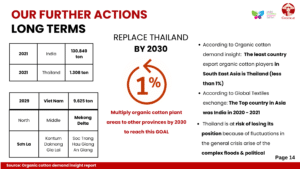
B2. Financial stability and profitability
(See the financial details in confidential folder at point B.2)
Explain how your business model ensures long-term financial stability and profitability
The revenue streams are proven
Financial projections based on valid data are strong
Financial Analysis & Projection (financial & WACC file in confidential)
During 5 years of operation from 2019 up to now, Green Cat has made a significant development in the main product lines of sustainable handbags and accessories. With more than 25 products and 75+ respective models, we have successfully boosted the annual growth of revenue by more than 61% each year. In the first half of 2024, there was a slight drop in sales, which resulted from the fact that consumers had been tightening their pockets on unnecessary products (Vien Thong 2024). Hence, by expanding the distribution partners and launching new affordable products, we expect the revenue from this activity can increase 30% annually since this year.

Regarding the cotton project, after two years of trial cultivation, we plan to officially launch it in 2025. The main assumptions for the projections including:
+ The correlation between cultivation area (1,000 m2), raw cotton (kg) and seeds (kg) can be fixed at the ratio of 1:100:50. The number was based on the trial cultivation during the last two years.
+ Organic cotton price will be fixed at 70,000 VND (~ 2.8 USD) per kg during the projected period.
The output is projected based on the capacity of co-operatives that have currently partnered with Green Cat in 3 provinces – Hoa Binh, Thanh Hoa and Ha Giang.



With the cooperation with N’go shoes and other partners mentioned in the previous parts, we expect the revenue can surge during the first 3 years of the project. However, the revenue can grow steadily from 2028-2029. During this stage, GS focuses on increasing productivity and developing a sample procedure which could be also applicable for other provinces in the future.
Accordingly, the cash inflows and outflows are projected as in the table below.
Based on the calculation, the project can not only pay back full initial investment in the fourth year but also bring back up to $11 for each $100 invested.
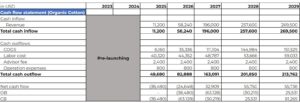
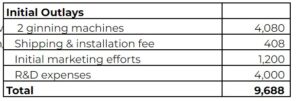
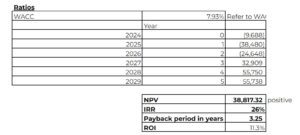
Risk management
The most critical risks involved in the best case – worst case scenario are cotton price volatility, the natural factors such as weather and the organic compliance of farmers.
As proven in the practice, the cotton cultivation in Vietnam poses the high opportunity cost against other plants, which means farmers are willing to give up cotton for comparatively higher payoff plants. Therefore, if the price of organic cotton was not attractive enough, the assumption of remarkable expansion in cotton crop is prone to fail.
Moreover, due to the nature of agriculture, cultivation depends heavily on weather conditions. For example, any sudden drought can severely reduce the cotton harvest. Such adverse weather has actually been frequent and hard to predict.
The last risk is a human factor. Since the organic standards prohibit the participation of chemical fertilizer and pesticides, it requires more dedication and commitment of farmers to grow a crop.
While both of the first factors can directly impact on the revenue of a project by influencing the value and quantity of the crop, the last one can lead to the variation of management fee to supervise the compliance.

According to the calculation, in the worst case, where both cotton price and output drop to half and the management fee increase by 30%, the project shows a poor growth, which ends up with suffering huge losses and no payment back to the investors.
To mitigate the risk, we have planned some suggestions. Firstly, the application of options can help to reduce the fluctuation of cotton prices. Meanwhile, the adoption of agricultural insurance can economically protect the farmers from poor crops. Moreover, applying technological improvements to cultivating systems can somehow ease the damage of adverse weather to crop by putting the variables under control. Regarding the last problem, the close relationship between Green Cat with governments, as well as local organization will contribute to controlling organic compliance of farmers
(Please find the sheet WACC Calculator in Confidential folder at point B.2)
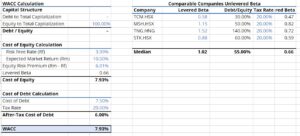
B3. Team and leadership (Ref B.3)
Explain how your team’s expertise and leadership capability enhance the project’s ability to achieve its dual objectives of profitability and social impacts.
There is strong evidence proving that the team members’ competencies and capabilities are strong and complementary
There is strong evidence of synergy among team members
There is a solid track record of comprehensive expertise and proven leadership with both business acumen and a strong commitment to social impact.
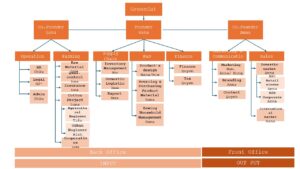
Team Spirit
- Hanna: learned about fashion materials after working in the textile industry for ten years. Inspired by natural fibers and the beauty of traditional products, her desire is to support local businesses and women in Vietnam. To further develop her specialized skills, Hanna attended exhibitions held in Hong Kong, Italy and especially a 3-month trip to France following the Linen and Hemp Fabric Associations. Be inspired by startup stories from people in the industry. As someone who has been exposed to a variety of materials, she clearly understands the structure and advantages of each type of material. She is also very passionate about learning natural materials. When touching on natural raw materials such as hemp, cotton and the stories surrounding this natural material source in the cultivation and production of Vietnamese traditional craft villages. Hanna was inspired by ecological ideology as well as the desire to preserve the traditional textile industry of the Vietnamese highland people and contribute to promoting the fashion industry in a better direction.
-
- Luna: has a great passion for the diversity of different cultures and traditions. She has over 10 years of experience in the field of promoting empowering women and sustainable development through non-profit activities for women, minorities and disadvantaged communities. Luna is talented at expanding networks and has experience managing and operating small companies. In 2019, she formed The Eco-lifestyle shop where she practices transitioning to a waste-reducing, and more sustainable lifestyle. She also organizes improvisational game activities and workshops to help young people raise environmental awareness. It was an ideal destination and one of the most well-known places for young people and foreign tourists. Luna met Hannah there for collaboration. Luna joined Green Cat Founder Council in 2023 and contributes to business growth as well as brand communication that help promote Green Cat’s image and core values to target customers.
- Not only that, she continues her personal development journey through leadership capacity improvement programs such as:
- Future For Women is organized by For Good Vietnam and sponsored by the Echidna Giving Foundation.
- Academy For Women Entrepreneurship is sponsored by the US Consulate
- She is currently a board member of Women Entrepreneurship For Community Vietnam (WECV) community & Leading Team to SBC Competition.
- Anna: She has strong experience in the Marketing field and her career path is mainly developing in Corporate. After a long journey working in corporate, Anna thinks it’s time for her to try her hand at a challenging field like a startup business environment and also wants to contribute to creating value for the vulnerable community. She is inspired by the Greencat story and wants to contribute her talent to our project for defining & approaching the potential market for business growth.
- Like-minded people naturally gravitate towards each other
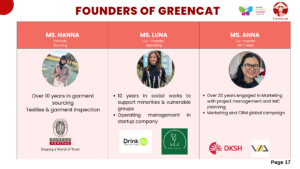

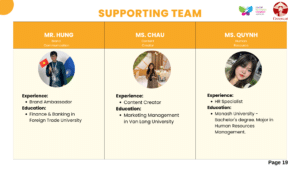
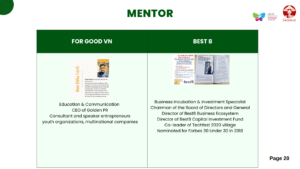
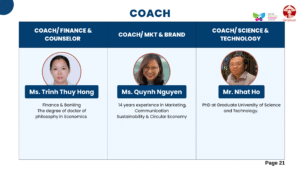
- B4. Partnership and collaboration Explain how you leverage partnerships or collaborations to amplify your social impacts.
- There is strong evidence of important potential partners’ responses to the project’s call for collaboration
- There are quality collaboration pledges from key partners
- There is strong evidence of deep commitment from key partners such as signed contracts, co-organization of important activities, etc.
Rising the middle class in Vietnam driving new trends of consumption
Vietnam’s rapidly growing young middle class makes the country a very appealing market for foreign brands.
It’s also anticipated that the Vietnamese people’s greater disposable income will promote domestic spending through electronic payment systems. Consumers are becoming more confident in domestic goods because they have a clear source and comparable quality to imported goods. According to the source of Asisa Oct 27th, 2022.
Implications for companies wooing Vietnam’s consumers
Vietnam’s consumer markets are changing rapidly—diversifying, modernizing, and digitizing. Companies can find considerable momentum to tap into, but to position themselves in a way that can win the hearts and minds of Vietnamese consumers, they need to answer questions about which markets to enter, how to communicate with consumers, and how to maintain a combination of localization and agility. According to the article: The new faces of Vietnamese consumers Dec 7th, 2021.
If you want to go far, go together
Understanding the crucial significant context in the market, our development strategy is to develop symbiotically with other startup brands with the same goal of sustainable development.
| Input | Output | |
| Luc Nghiep Thanh Cooperative: cotton crops to fabrics
Can Ty Cooperative: hemp fabrics |
Domestic Market | Export |
| Green Cat: fashion product | N’go shoes: cotton fabrics | |
| Kaban – LustinArt: cotton fabrics & cotton lint | MyOkies: fashion product | |
| Rural Development Support Fund
Hoa Binh Province Women’s Union |
WECV: networking
UEF University: service learning |
DBAV: export to Dutch |
| IID: Research crops
WWF: Training Skill |
||
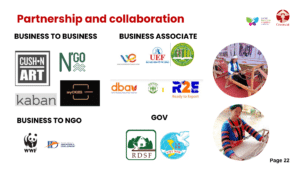
Business to Business
| Luc Nghiep Thanh Cooperative | Our key partner in starting cotton cultivation and weaving cotton fabric has been supplying us since 2019 and up to now the cooperative continues to develop growing areas so we can find outlets for our product lines. from cotton | |
| Can Ty Weaving Cooperative | Our long-time partner in providing hand-woven hemp fabric with traditional hand-dyeing techniques from skilled middle-aged Hmong women. We have combined and sent hand-woven cotton fabric from Hoa Binh so that the ladies can dye the fabric to achieve the best color quality. | |
| N’go Shoes | The potential of collaboration in 2025 for sourcing handwoven cotton
Green Cat approached N’go shoes to propose a cooperation in providing Green Cat’s hand-woven cotton fabric with N’go Shoes in 2022 via email. Recently when they received our update about the organic cotton farm expanding this year. N’go Shoes has the same goal and mission as Green Cat when it comes to adding value to handwoven fabrics made by ethnic minority artisans in Vietnam. The difference between us is that N’go does not yet have products made from organic cotton. When they heard us share about the project, they agreed to the proposal to cooperate with Green Cat and schedule a meeting when the founder of N’go shoes has a business trip to Vietnam in November this year. |
|
| My Okies | Our new sales strategy from September 2024 is to integrate electronic wallets through MyOkies online platform to increase the convenience of the shopping experience for customers. Green Cat also cooperates with My Okies to expand sales channels to the US market from April 2025.
MyOkies is an online sales platform based in the US with the goal of promoting quality Vietnamese products closer to domestic and US consumers in the future. The service utility is a quick payment gateway, accepting international payment cards and committing to quick delivery times. In our agreement, from August we will launch an online store on Myokies’ website and coordinate with the third partner – Mur Mur working cafe, to make a pickup point for goods and will officially announce on the media channels of all 3 parties: Green Cat – Myokies – Mur Mur after the work of setting up the booth and receiving goods has been completed. MyOkies will also connect Green Cat with the 5-star Marriott hotel system to cooperate in consigning and displaying products in the form of an affiliate contract starting from September this year. And also the sponsor of the Green Cat boot design display category in the Grand Final event organized by SBC at Hec Montreal. |
|
| Kaban & CushnArt | Kaban & CushnArrt Brands
They are two brands belonging to the same New Revolution Company founded by Hiro Kadosa and Selene Alcock as a small manufacturer and key relationships ensure transparency in the supply chain. Those 2 retails brands had a pause during Covid time and they are working on re-opening their brands. Green Cat proactively approached Mr. Through connections in the R2E community, Hiro discussed the possibility of cooperation between the two brands in the near future. We have also scheduled an appointment to discuss details on Thursday next week |
|
Business Associate
| Dutch Business Associate in Vietnam(DBAV) – Asia Society for Sustainable Improvement and sustainable (Assist) | To prepare for export, Green Cat has registered to participate in an intensive training course to increase export capacity to the Dutch market. The goal is to reach diverse markets, in which we will target the Dutch market for handwoven fabric and handmade products. |
Service-Learning Center, University of Economics and Finance (UEF) |
UEF and Green Cat have cooperated together in implementing case studies for integrated courses to serve the community in the 2023 – 2024 school year. This year, Green Cat continues to accompany UEF in this activity and bring the project reinstating cotton plants into the topic so that students have more opportunities for practical experience and a more diverse perspective from a startup with an agriculture-oriented model. |
| Women Entrepreneurship Community Vietnam (WECV) | WECV has been our community partner since 2023, they help to promote our brand and get closer to potential partners. This year, WECV continues to accompany Green Cat in connecting with the community through organizing workshops and introducing Green Cat’s journey to help Green Cat access more suitable resources for promotional activities. |
Industry organizations that we will continue to reach out to in Quarter 4, 2024 include:
| NGO | Coordinate project implementation with WWF in crop cultivation and with IID in coordinating training to improve skills with local people |
| GOV | Through Luc Nghiep Thanh Cooperative, Green Cat’s key partner in regenerating cotton growing areas. We will reach out together
|
- ESG reporting
C1. Measurement and reporting
Describe how you measure and report your impacts according to environmental, social, and
governance (ESG) criteria.
The data collection is rigorous to ensure data quality and insightful interpretations
The reports allow stakeholders to evaluate ESG performance over time and draw insights about the trends and improvements
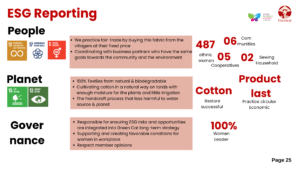
To encourage peer learning and modeling, we sought to highlight good ESG practices adopted by some of our issuers in this section.
| Environment: | 100% Textiles from natural, biodegradable
Cotton, Hemp, Cork |
| The process:The handcraft process that less harmful to water source & planet | |
| Social: | For Ethnic Women Artisan
We practice fair-trade business with the local communities to which we buy the dyed fabrics. By buying this fabric from the villagers at their fixed price and might higher the market according to the time and difficulty that the dying requires. We want to encourage the preservation of this ancestral know-how at our level. For women in workplace Green Cat focuses on supporting and creating favorable conditions for women, especially vulnerable groups of women. During the market testing phase, Green Cat chose to work with small garment factories where women were single mothers or middle-aged. Although the women here initially did not have high skills in sewing bags and were not familiar with working with natural fibers, both sides struggled during the stage of understanding each other. Our point of view is to work side by side, providing information and guidance until both sides achieve the common goal and achieve success in sowing this seed. For partner to consumer When coordinating with business partners who have the same goals towards the community and the environment. We not only grow together but also influence consumers so that they understand more about traditional products and understand more about natural materials and renewable materials that contribute to minimizing impacts. to the environment and symbiosis in accompanying disadvantaged communities to be better. |
Summary Data collection from Surveys complete by our partners and online consumers:
(Please see in confidential folder – Reference file at point B.4)
- 8 answers from partners surveys
- 53 answer from customer surveys

B Impact Assessment Performance Overview (Confidential folder)
B-Lab – a global non-profit enterprise, certifies businesses that achieve the highest standards for balancing social and for-profit purposes. More specifically, the standards include environmental and social impact, public transparency, and legal responsibility.
The web app is easy to access and helps us navigate clearly the social responsibilities we need to fulfill to become a better social enterprise
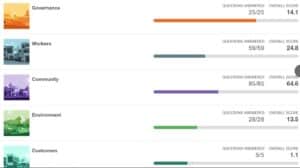

C2. Compliance with ESG standards and frameworks
Explain the ESG standards and frameworks you adopt.
There is strong evidence of effort to comply with the chosen standards and framework
The project engages internal and external stakeholders to gain an objective assessment of its compliance level and to understand industry best practices
Compliance with the chosen standards and framework are well communicated
Cotton Farming:
To carry out the cotton regeneration project, we have thoroughly researched the risks and impacts on the environment, including considering organic farming – legal procedures to prepare for registration. Signed USDA organic certification
Evaluate the project’s sustainable development capabilities through in-depth interviews with experts and guests in many professional fields related to the project.. See the evidence video in confidential folder
| 1 | Organic agriculture engineer | Interview about organic farming techniques, how to achieve productivity while still complying with natural growing standards |
| 2 | Urban Engineer | Interview opinions about the feasibility of the project, consider the genetics of seedlings, the source of arable land and avoid forest land |
| 3 | Bitis Corporation
Footwear manufacture in Vietnam |
Interview about expansion orientation in 5 years based on Green Cat’s cur
rent capacity to develop safely each year |
According to requirement of USDA application: Currently, Control Union has not received any more evaluation projects because USDA is changing the process, it will take another 6-8 months to receive new projects; But during this time, Green Cat and cooperative to build documents and planting areas to ensure compliance with the requirements of the standards – Consulting time is about 6 months.
FYI: USDA has certification for Growing Areas, and certification for Processed Products.
According to email TQC GLOBAL TESTING AND CERTIFICATION CENTER June 22nd, 2024
Employment
During 5 years of market testing, Green Cat had no official employees. We only have contract personnel and charge hourly wages. However, compared to the general average, Green Cat pays a higher hourly wage than the minimum wage regulations by region and compared to the specific market as follows:
| Minimum salary prescribed by region:
22.500 VNd/ hour |
Minimum salary prescribed by common market:
25.000 VND – 30.000 VND/ hour |
Minimum salary prescribed by Green Cat
35.000 VND/ hour Pay slip in evidence folder |
Fairtrade
Although we have been practicing fair trade with relevant parties in our operations, our goal is to register according to this standard from 2025 to 2030 to apply to the cotton growing area model.
According to B-Corp Assessment Performance Overview of fiscal year 2024, Green Cat set goal towards to 2025 as follows:
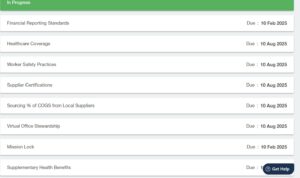
Learning curve
Describe what you have learned from the fieldwork and how you improve your project.
Evidence of the learning process is credible
Evidence of the transformation in the mindset, behavior, and strategy is credible
Since participating in the contest organized by SBC, I have had the opportunity to clearly define the social issues that Green Cat wants to solve and it is also an opportunity for us to clearly define the problems businesses must improve for business sustainable growth
- Round 1 and Round 2: I lacked understanding of how to do well and I was weak in presentation skills. However, thanks to my efforts to reach the final journey, along with the help of my coach and team, I completed the past rounds well with the result that was good enough for my motivation.
- Round 3: When investing more time in data collection and research. I am more bold in seeking outside sources of support and boldly sharing about the project to receive opinions from related experts.
- Round 4:
- From this round we also learned how to seize the moment in direction from “Top to down” perspective and consider the actual possibilities upward “bottom up”.
- Understand clearly the limitations of the project and be flexible in setting short-term – medium-term – long-term goals to help the project be implemented in a feasible way and thereby attract resources to participate accordingly at each stage.
- Boldly connect with parties in the garment supply chain to receive feedback, as well as propose cooperation with potential partners to create value for the project. Details in confidential folder
- Learning requires coordination and how to mobilize resources to increase influence



